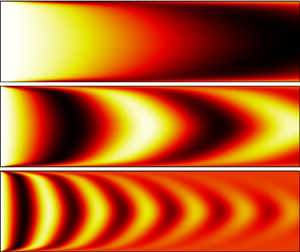Article contents
A global linearized framework for modelling shear dispersion and turbulent diffusion of passive scalar fluctuations
Published online by Cambridge University Press: 29 March 2021
Abstract

In the field of gas-turbine engineering, entropy waves and fluctuations in fuel–air mixing are of significant importance. The impact of either mechanism on thermoacoustic stability of the engine and combustion noise considerably depends on how they are convected in the combustion chamber. In this work, a novel method is employed to analyse their convection. Both effects are modelled using a transport equation of a passive scalar linearized around the mean field. The linearized transport equation is discretized using finite elements. It is shown that turbulent passive scalar transport can be described by an eddy diffusivity in the linear framework. The method is furthermore validated against direct numerical simulation (DNS) of passive scalar transport in a turbulent channel flow. Taking the mean flow from the DNS as input, the method reproduces transport of periodic passive scalar fluctuations with high accuracy at negligible numerical expense. Previous studies investigated destructive interference of the passive scalar due to a non-uniform mean flow profile, a process termed mean flow shear dispersion. The method introduced in this study, however, allows us to additionally quantify the impact of molecular and turbulent diffusion. For the channel flow under investigation, mean flow shear dispersion is the dominant mechanism at low frequencies while, at higher frequencies, turbulent diffusion needs to be accounted for to reproduce the DNS results. Molecular diffusion, however, only has a minor effect on the overall convection in the turbulent channel flow.
- Type
- JFM Papers
- Information
- Copyright
- © The Author(s), 2021. Published by Cambridge University Press
References
REFERENCES
- 6
- Cited by





